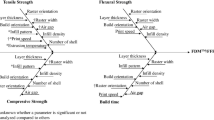Abstract
In this work, Polycarbonate (PC) filament was manufactured and utilized to 3D print tensile test specimens for the optimization of two 3D printing parameters (temperature and layer height) in relation to the Ultimate Tensile Strength (UTS, σb) and the Elastic Modulus (E). First, the general full factorial Design of Experiments (DOE) was followed, and three levels of both the Layer Height (LH) and the Nozzle Temperature (NT) were employed for the experiments. Then, the nine combinations were 3D printed, three times each. The average and the max–min differences (Δσb and ΔE) were calculated for both the σb and E. Subsequently, Main Effects Plots (MEP), interaction charts, and Analysis of Variances (ANOVA) were utilized to determine the effects of the LH and NT on σb, E, Δσb, and ΔE. The mechanical response of PC in 3D printing was investigated and the models developed for the two parameters were studied to provide the required scientific information to optimize the process. It was found that both the LH and the NT are essential parameters for determining the mechanical response. LH of 0.2 mm and NT of 270 °C optimized the study objectives, i.e., maximizes the σb and E and minimizes the Δσb and ΔE.









Similar content being viewed by others
Availability of data and materials
The raw data presented in this study are available on request from the corresponding author.
References
Goh GD, Yap YL, Tan HKJ et al (2020) Process–structure–properties in polymer additive manufacturing via material extrusion: a review. Crit Rev Solid State Mater Sci 45:113–133
Ngo TD, Kashani A, Imbalzano G et al (2018) Additive manufacturing (3D printing): a review of materials, methods, applications and challenges. Compos B Eng 143:172–196
Savvakis K, Petousis M, Vairis A et al (2014) Experimental determination of the tensile strength of fused deposition modeling parts. American Society of Mechanical Engineers, New York, p V014T011A022
Serini V (2002) Polycarbonates. Ullmann’s encyclopedia of industrial chemistry. Wiley-VCH Verlag GmbH & Co, New Jersey. https://doi.org/10.1002/14356007 (ISBN: 9783527306732)
Bendler JT (1999) Handbook of polycarbonate science and technology. CRC Press, London
Reich MJ, Woern AL, Tanikella NG et al (2019) Mechanical properties and applications of recycled polycarbonate particle material extrusion-based additive manufacturing. Materials 12:1642
Masood SH, Mau K, Song W (2010) Tensile properties of processed FDM polycarbonate material. Mater Sci Forum 654:2556–2559
Kumar M, Ramakrishnan R, Omarbekova A, Kumar SR (2021) Experimental characterization of mechanical properties and microstructure study of polycarbonate (PC) reinforced acrylonitrile-butadiene-styrene (ABS) composite with varying PC loadings. AIMS Mater Sci 8(1):18–28. https://doi.org/10.3934/matersci.2021002
Park SJ, Lee JE, Lee HB et al (2020) 3D printing of bio-based polycarbonate and its potential applications in ecofriendly indoor manufacturing. Additi Manuf 31:100974
Kalia K, Ameli A (2018) Tensile properties of 3D-printed polycarbonate/carbon nanotube nanocomposites. American Society of Mechanical Engineers, New York, p V002T008A008
Domingo-Espin M, Borros S, Agullo N et al (2014) Influence of building parameters on the dynamic mechanical properties of polycarbonate fused deposition modeling parts. Print Addit Manuf 1:70–77
Gupta A, Fidan I, Hasanov S et al (2020) Processing, mechanical characterization, and micrography of 3D-printed short carbon fiber reinforced polycarbonate polymer matrix composite material. Int J Adv Manuf Technol 107:3185–3205
Santhakumar J, Maggirwar R, Gollapudi S et al (2016) Enhancing impact strength of fused deposition modeling built parts using polycarbonate material. Indian J Sci Technol 9:1–6
Smith WC, Dean RW (2013) Structural characteristics of fused deposition modeling polycarbonate material. Polym Test 32:1306–1312
Syamsuzzaman M et al (2014) Investigation of layer thickness effect on the performance of low-cost and commercial fused deposition modelling printers. Mater Res Innov 18(sup6):S6-485-S6-489
Chaidas D, Kechagias JD (2021) An investigation of PLA/W parts quality fabricated by FFF. Mater Manuf Process. https://doi.org/10.1080/10426914.2021.1944193
Kechagias JD, Ninikas K, Petousis M et al (2021) An investigation of surface quality characteristics of 3D printed PLA plates cut by CO2 laser using experimental design. Mater Manuf Process. https://doi.org/10.1080/10426914.2021.1906892
Aslani K-E, Chaidas D, Kechagias J et al (2020) Quality performance evaluation of thin walled PLA 3D printed parts using the taguchi method and grey relational analysis. J Manuf Mater Process 4:47
Aslani K-E, Kitsakis K, Kechagias JD et al (2020) On the application of grey Taguchi method for benchmarking the dimensional accuracy of the PLA fused filament fabrication process. SN Appl Sci 2:1–11
Funding
No funding was received for conducting this study.
Author information
Authors and Affiliations
Contributions
Conceptualization: NV and JK; methodology: NV and JK; formal analysis and investigation: JK and MP; writing—original draft preparation: JK; writing—review and editing: JK and MP; funding acquisition: NV; resources: NV and JK; supervision: NV and JK. All authors have read and agreed to the published version of the manuscript.
Corresponding author
Ethics declarations
Conflict of interest
The authors have no conflicts of interest to declare that are relevant to the content of this article.
Rights and permissions
About this article
Cite this article
Vidakis, N., Petousis, M. & Kechagias, J.D. A comprehensive investigation of the 3D printing parameters’ effects on the mechanical response of polycarbonate in fused filament fabrication. Prog Addit Manuf 7, 713–722 (2022). https://doi.org/10.1007/s40964-021-00258-3
Received:
Accepted:
Published:
Issue Date:
DOI: https://doi.org/10.1007/s40964-021-00258-3




